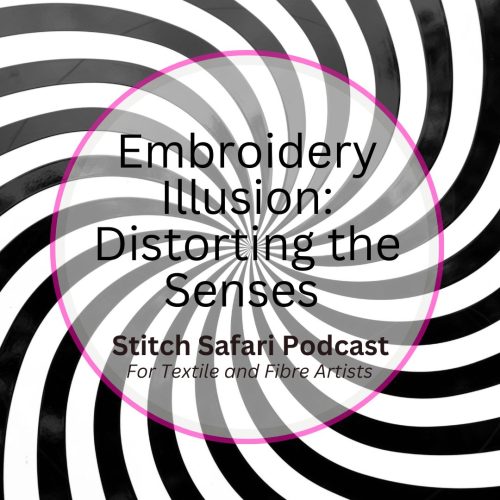Pockets for women were often worn hidden beneath the clothing of women of rank. Working women tended to wear their tie-on pockets over their garments where they were easily accessible.
Small and seemingly insignificant, women’s pockets were worn independently from approximately 1650 to 1900 – their resilience spanning 250 years of transformative British history, witnessing unparalleled developments in manufacturing, consumption, and global trade. Yet they maintained their usefulness and relevance.
In these pockets can be seen the spread of cotton, advances in industrial weaving, the advent of the sewing machine as well as new innovations in spinning, textile printing, and dyeing techniques.
But women’s tie-on pockets also witnessed major changes in the social, legal, and political status of women, corresponding with the development of women’s rights, forming a nexus of historical insights into women’s sociability, mobility, domesticity, work, materiality, financial independence, purchasing practices, privacy – even their sense of self.
Otzi the Iceman, a perfectly preserved body dating from 3,300 BCE offers proof of a pocket-like feature – a pouch sewn onto his belt providing a cache for a scraper, a drill, a flint flat, a bone awl, and some dried fungus.
Similar tie-on pouches date back to the Middle Ages, with tailors devising means of securing internal, sewn-in pockets for men – accessed by conveniently placed external openings, yet women were relegated to the tie-on pocket accessed through openings in their clothing.
While women’s stories are heavily under-reported, there’s evidence of the narratives these richly decorated, treasured pockets tell, but it’s to novels, diaries, letters, newspapers ads for lost pockets, and the records of criminal trials that we have to turn for information.
Records from London’s Old Baily court 1674-1913 run a close parallel to the use of tie-on pockets, with 572 cases involving tie-on pockets, including pickpocketing, highway robbery, shoplifting, burglary, larceny, housebreaking, theft with violence, murder, infanticide, and coining.
The information gleaned from the indictments and testimonies give precious information about their value, materials, and practices, giving us an understanding of what these pockets contained and why they mattered to the women who owned them.
Tie-on pockets have now been revealed by historians as socially and culturally embedded artifacts – markers and carriers of meaning and memory, so as mundane as they initially appear, they engage and open new ways of looking at women’s lives, from their own viewpoint from the past.
The very nature of extant textiles absorbs and retains evidence of its uses and abuses, its wear and tear, repairs and care, cleaning and degradation, accidental and intentional marks, as well as its manner of construction, which together, form a physical, historical record of these seemingly simple objects.
Often embroidered and hidden away from sight, tie-on pockets also provide insight into the tasks and responsibilities that shaped women’s daily lives, connecting the rich to the humble showing their social diversity stretching between fashionable aristocrats to servants and market-stall holders.
So regardless of the financial disparities of the owners of tie-on pockets, they functioned in equally important ways for all.
Historians question whether the detachability of women’s tie-on pockets represented a less structured, more elastic relationship with their possessions?
The tapes used on tie-on pockets often broke or came undone due to the strain of their possession but they were also vulnerable to being torn, cut, snatched, or pulled off, yet could also be easily taken off without disrobing – a number of times if required.
The gendered politics of pockets came into play in a 1914 short story by Charlotte Perkins Gilman ‘If I Were A Man’, where pockets are among one of the revelations Gilman writes about when turning into her husband for a day. This was a time when feminists were demanding both dress and political equality.
Made from almost any available, durable fabric including leather, tie-on pockets were often embroidered in silks or wools using floral decorative motifs sometimes personalized with the maker’s initials.
Attached in pairs, singles, or several pairs, they could also be worn from the sides or from the front making them extremely versatile.
Working women often kept small tools such as penknives, bodkins, pencils, corkscrews, and even their spectacles close at hand, however, women in polite society carried things like snuff boxes, personal seals, smelling salts, toothpick cases, combs, bodkins, pocket-books, small almanacs, pencils, silk purses and sometimes watches, botanical field guides and telescopes to be used on rambling walks.
Fashions came and went – the crinoline, the bustle, and high-waisted fashions yet the tie-on pocket remained almost unchanged, however, the charming pocketed skirt suits of the 1880s and ’90s, symbolic of the ‘new woman’, became the focus of satire suggesting that women emulated masculine behaviors and gestures while wearing them.
Women’s tie-on pockets were often matched to garments such as a 1775 blue wedding dress or a pair of yellow silk quilted pockets matching a lightly boned waistcoat, but they were also used as part of a war on words by the fashion industry to push sales of the reticule.
The positioning of pockets was seen to allude to carnal desires and sexual associations – drawers were not in use until the 1840s and not in common use till the 1880s.
The Suffragette movement is significant as they sought to determine that women deserved clothing that matched their choices and needs – including how many or few pockets they had. A number of Suffragettes posed for photos wearing ‘the suffragette coat’, confronting audiences of the time because they hand their hands deep into large pockets.
Ironically, men from this same era, hands-in-pockets were deemed to show power, poise, and a calm demeanour.
Patchwork and applique repurposed small pieces of precious fabrics to make pockets, however, embroidery was by far the most popular method used to decorate pockets, with patterns shared and circulated between women – usually family members or friends.
Pockets became a widely distributed commodity sold in shops – a modern development in the early 1700s, but they were also sold by itinerant sellers and made for sale by poor girls in schools.
So the simple tie-on pocket survived, registering both continuity and change in women’s lives while recording their engagement with an expanding material world crossing all social spectrums.
Tie-on pockets made use of recycled fabrics, were used as teaching tools, and were transmitters of design while reinforcing the familial and friendship networks between women, connecting women’s inner and outer worlds – a world of politics and protest to that of a humble worker making a living.
All from a simple pocket.





